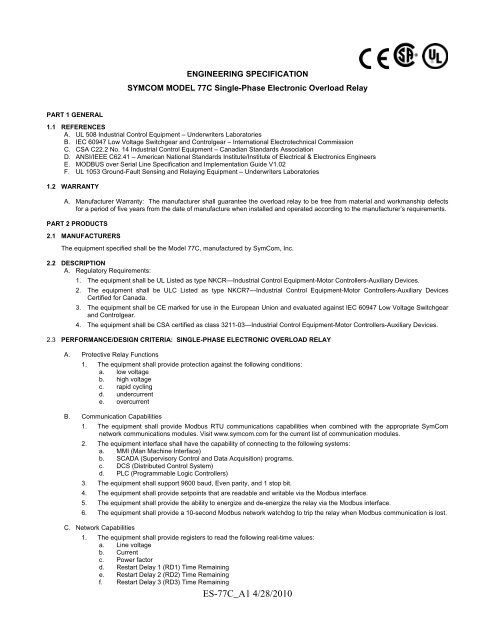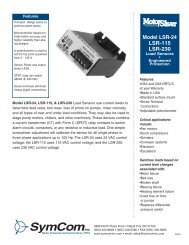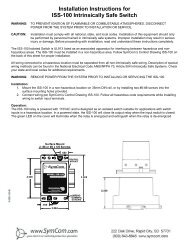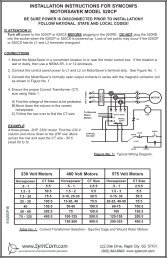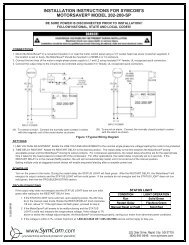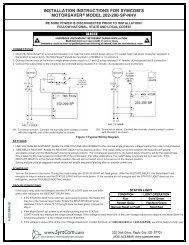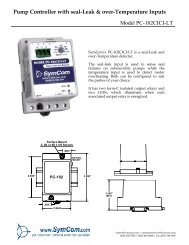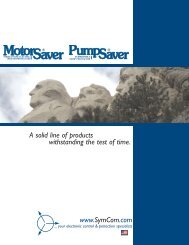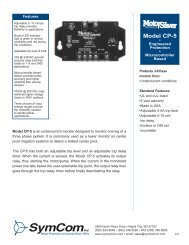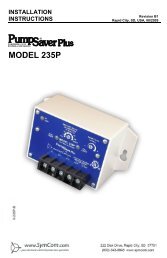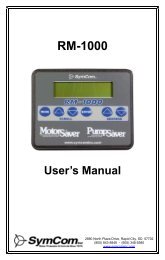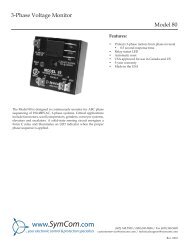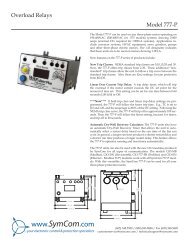PD - SymCom
PD - SymCom
PD - SymCom
You also want an ePaper? Increase the reach of your titles
YUMPU automatically turns print PDFs into web optimized ePapers that Google loves.
ENGINEERING SPECIFICATIONSYMCOM MODEL 77C Single-Phase Electronic Overload RelayPART 1 GENERAL1.1 REFERENCESA. UL 508 Industrial Control Equipment – Underwriters LaboratoriesB. IEC 60947 Low Voltage Switchgear and Controlgear – International Electrotechnical CommissionC. CSA C22.2 No. 14 Industrial Control Equipment – Canadian Standards AssociationD. ANSI/IEEE C62.41 – American National Standards Institute/Institute of Electrical & Electronics EngineersE. MODBUS over Serial Line Specification and Implementation Guide V1.02F. UL 1053 Ground-Fault Sensing and Relaying Equipment – Underwriters Laboratories1.2 WARRANTYA. Manufacturer Warranty: The manufacturer shall guarantee the overload relay to be free from material and workmanship defectsfor a period of five years from the date of manufacture when installed and operated according to the manufacturer’s requirements.PART 2 PRODUCTS2.1 MANUFACTURERSThe equipment specified shall be the Model 77C, manufactured by <strong>SymCom</strong>, Inc.2.2 DESCRIPTIONA. Regulatory Requirements:1. The equipment shall be UL Listed as type NKCR—Industrial Control Equipment-Motor Controllers-Auxiliary Devices.2. The equipment shall be ULC Listed as type NKCR7—Industrial Control Equipment-Motor Controllers-Auxiliary DevicesCertified for Canada.3. The equipment shall be CE marked for use in the European Union and evaluated against IEC 60947 Low Voltage Switchgearand Controlgear.4. The equipment shall be CSA certified as class 3211-03—Industrial Control Equipment-Motor Controllers-Auxiliary Devices.2.3 PERFORMANCE/DESIGN CRITERIA: SINGLE-PHASE ELECTRONIC OVERLOAD RELAYA. Protective Relay Functions1. The equipment shall provide protection against the following conditions:a. low voltageb. high voltagec. rapid cyclingd. undercurrente. overcurrentB. Communication Capabilities1. The equipment shall provide Modbus RTU communications capabilities when combined with the appropriate <strong>SymCom</strong>network communications modules. Visit www.symcom.com for the current list of communication modules.2. The equipment interface shall have the capability of connecting to the following systems:a. MMI (Man Machine Interface)b. SCADA (Supervisory Control and Data Acquisition) programs.c. DCS (Distributed Control System)d. PLC (Programmable Logic Controllers)3. The equipment shall support 9600 baud, Even parity, and 1 stop bit.4. The equipment shall provide setpoints that are readable and writable via the Modbus interface.5. The equipment shall provide the ability to energize and de-energize the relay via the Modbus interface.6. The equipment shall provide a 10-second Modbus network watchdog to trip the relay when Modbus communication is lost.C. Network Capabilities1. The equipment shall provide registers to read the following real-time values:a. Line voltageb. Currentc. Power factord. Restart Delay 1 (RD1) Time Remaininge. Restart Delay 2 (RD2) Time Remainingf. Restart Delay 3 (RD3) Time RemainingES-77C_A1 4/28/2010
g. Trip status of the following:1) Network off command status2) Undercurrent3) Overcurrenth. Last fault 1i. Last fault 2j. Last fault 3k. Last fault 4l. Unit IDm. Model coden. Motor run hours2. The equipment shall provide the following readable/writable setpoints:a. Low voltage trip pointb. High voltage trip pointc. Current multiplierd. Overcurrent trip pointe. Undercurrent trip pointf. Trip class setpointg. Restart delay 1 setpointh. Restart delay 2 setpointi. Restart delay 3 setpointj. Number of restarts after an undercurrent fault (#RU) setpointk. Number of restarts after a fault (#RO) setpointl. Undercurrent trip delay setpointm. Modbus address setpointn. Network status setpoint to enable the following features:1) Network watchdog2) Network program disable3) Front panel locko. Time units setpointp. Linear overcurrent trip delayq. Command line to respond to the following commands:1) Network program enable2) Network program disable3) Clear run hours4) Clear last fault5) Enable network watchdog6) Disable network watchdog7) Start the motor8) Stop the motorD. Capabilities and Features1. Inputsa. The equipment shall require a single-phase input voltage of 100-240VAC.b. The equipment shall require a single-phase 50/60 Hz input voltage.c. The equipment shall provide a connection to an optional external remote reset switch.d. The equipment shall require no external CT’s for motors with full load current ratings between 2 and 90 amps.e. The equipment shall require external CT’s for motors with full load current ratings greater than 90 amps.f. The equipment shall accept full load current of 2-800 amps.2. Outputsa. The equipment shall include one Form C (S<strong>PD</strong>T) output relay. Contacts pilot duty rated 480VA@240VAC.Contacts general purpose rated 10A@240VAC.3. Functional Specificationsa. The equipment shall include the following front panel setpoint ranges:1) an adjustable low voltage (LV) setpoint range of 85-262VAC2) an adjustable high voltage (HV) setpoint range of 86-264VAC3) an adjustable trip class (TC) setpoint range of 5, J5, 10, J10, 15, J15, 20, J20, 30, J30, Lln4) an adjustable rapid-cycle timer 1 (RD1) of 0, 2-500 seconds5) an adjustable motor cool-down timer (RD2) of 2-500 minutes6) an adjustable undercurrent restart delay timer (RD3) of 2-500 minutes7) an adjustable number of restarts after undercurrent (#RU) setpoint range of 0-4, A (automatic)8) an adjustable device communication address (ADDR) setpoint range of A01-A999) an adjustable number of restarts after OC faults (#RO) setpoint range of 0-4, A (automatic)10) an adjustable undercurrent trip delay (UCTD) setpoint range of 2-60 seconds11) an adjustable linear overcurrent trip delay (OPT1) setpoint range 2-60 seconds12) an adjustable setting to define RD2 and RD3 in seconds or minutes (OPT2) of 1-313) an adjustable multiplier (MULT) setpoint range of 1-10, 100, 150, 200, 300, 400, 500, 600, 700, 80014) an adjustable overcurrent (OC) setpoint range of (20-100A) ÷ MULT or 80-120% of CT PrimaryES-77C_A1 4/28/2010
15) an adjustable undercurrent (UC) setpoint range of (0, 10-98A) ÷ MULT or 40-100% of CT Primaryb. The equipment shall provide three independent adjustable restart delays:1) delay after power-up and rapid cycle2) delay after overcurrent faults3) delay after undercurrent faultsc. The equipment shall provide an undercurrent trip delay.d. The equipment shall allow manual or automatic restart after a fault.e. The equipment shall have the ability to display the last fault that caused the relay to trip off.f. The equipment shall provide the ability to view runtime information.g. The equipment shall provide a linear overcurrent trip delay.h. The equipment shall provide a method to enable or disable undercurrent.i. The equipment shall provide a front panel tamper guard, to prevent accidental setpoint changes.j. The equipment shall provide the ability to clear the last fault using the front panel.E. Timing Requirements1. The equipment shall provide an overload trip time that follows an inverse time trip curve.2. The equipment shall provide a linear overcurrent trip delay.F. Accuracy Requirements1. The equipment shall provide a timing accuracy on all timers of 5% ±1 second.2. The equipment shall provide a current measurement accuracy of ±3% for currents
I. Vibration/Shock Requirements1. The equipment shall withstand vibrations per IEC 68-2-6. Specified limits shall be 10-55Hz, 1mm peak-to-peak, 2 hours, 3axis.2. The equipment shall withstand shocks per IEC 68-2-27. Specified limits shall be 30g, 3 axis, 11ms duration, half-sinepulse.J. Dielectric Isolation: Equipment withstands an alternating current potential of 1000V plus twice the rated voltage of theequipment for 1 minute without breakdown between uninsulated live parts and the enclosure with the contacts open and closed;between terminals of opposite polarity with the contacts closed; and between uninsulated live parts of different circuits.K. Enclosure Class of Protection: The equipment shall provide IEC IP20 (finger safe) protection.L. Short Circuit Requirements1. The equipment shall provide a short circuit rating of 100kA.M. Environmental Requirements1. The equipment shall operate continuously without de-rating in ambient temperatures of -20° to 70°C (-4° to 158°F).2. The equipment shall operate continuously without de-rating in relative humidity of up to 95% non-condensing per IEC 68-2-3.3. The equipment shall operate properly after storage in ambient temperatures of -40° to 80°C (-40° to 176°F).N. Dimensions: The equipment dimensions shall not exceed 3.0” in height X 3.6” in width X 5.1” in depth.O. Mounting:1. The equipment shall be mountable on standard 35 mm DIN rail.2. The equipment shall be surface mountable.P. Conformal coating:1. The equipment shall contain harsh environment conformal coating to help extend product life and to protect from hostileenvironments including moisture, temperature variations, salt spray, organic attack (fungus), and aggressive chemicalsand vapors.End of SectionES-77C_A1 4/28/2010


